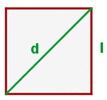Chapters
Diagonals are a part of a polygon. The best way to define a diagonal is that it is a line segment that joins two vertices. Diagonals are made on vertices that are not adjacent to each other. Diagonals depend on the vertices. If there are no vertices then there is no chance of a diagonal.

Number of Diagonals of a Polygon
To find the number of diagonals, you need to subtract three from the number of sides or vertices  . Let's say the total number of vertices is N, which means the diagonals will be
. Let's say the total number of vertices is N, which means the diagonals will be  . Every diagonal of any kind of polygon always has two ends, which mean that the before formula will count each one twice. Hence, we will be dividing it by 2 and the final equation to calculate the number of diagonals of a polygon will be:
. Every diagonal of any kind of polygon always has two ends, which mean that the before formula will count each one twice. Hence, we will be dividing it by 2 and the final equation to calculate the number of diagonals of a polygon will be:
 ,
,
where,  is the number of sides or vertices.
is the number of sides or vertices.
Calculation of Total Number of Diagonals of a Square




Calculation of Total Number of Diagonals of a Regular Pentagon and Regular Hexagon








Diagonal of a Square
The above formula is used to find the number of diagonals that a polygon will have. To find the length of the diagonal, each polygon has a different method. For squares, a different method is used and this method is only applicable on squares or any other polygon that is like a square. For this method, we will use the help of the Pythagorean theorem. Let's break the square into two equal parts and name the diagonal, "d".

By applying the Pythagorean theorem for one of the triangles, we obtain:



Example
Calculate the length of the diagonal for the square with a side of 5 cm.




Diagonal of a Rectangle

As mentioned before, every polygon has a different way to find the length of the diagonal and the rectangle is no exception. However, the method of derivation will be the same, just the values will be changed. By applying the Pythagorean theorem for one of the triangles, we obtain:
 .
.

Example
Calculate the length of the diagonal of a rectangle of 10 cm base and 6 cm height.

















I’m just curious if the area between the polygon and the circumscribed circle has a name.
https://www.superprof.co.uk/resources/academic/maths/geometry/plane/orthocenter-centroid-circumcenter-and-incenter-of-a-triangle.html